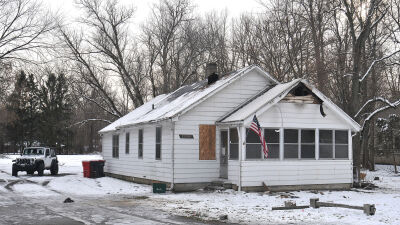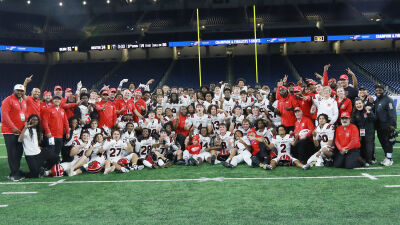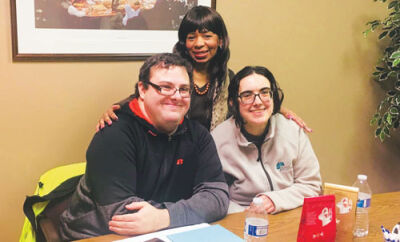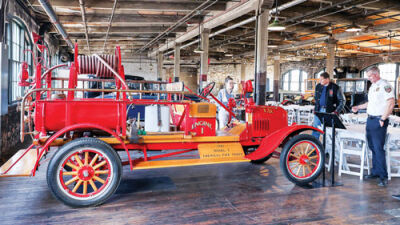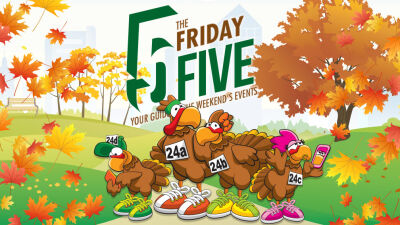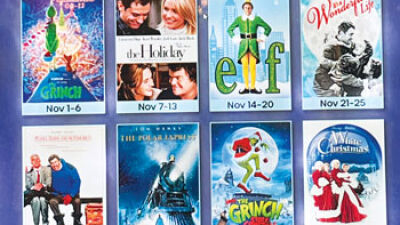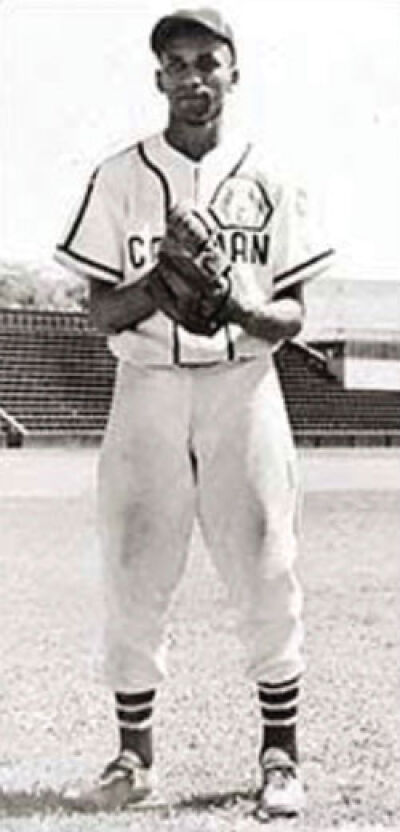
Ron Teasley suited up for the Carman Cardinals from 1949 to 1950, hitting around .300 and making the All-Star team, but the league never received the proper recognition of MLB scouts.
Photo provided by the Teasley family
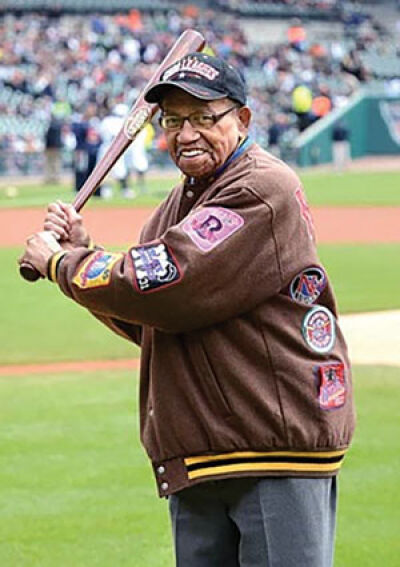
The Tigers have called upon Ron Teasley several times to throw out the ceremonial first pitch during the times the former Negro Leagues were celebrated.
Photo provided by the Teasley family
SOUTHFIELD — Growing up, Lydia Teasley couldn’t comprehend the importance of her last name, and who could blame her?
To Lydia Teasley, her father, Ron Teasley, was a renowned basketball and baseball coach at his high school alma mater, Detroit Northwestern High School, compiling numerous Detroit Public School League and district championships across both sports.
Ron Teasley was also the first African American student to play basketball, the first African American team captain, and the second African American to play baseball for the high school.
It wasn’t until elementary school when she first reaped the rewards of the Teasley name by being able to have complete freedom in gym class.
“I got to do anything I wanted to do,” Lydia Teasley said. “I thought, ‘Oh wait, this is pretty cool.’ I still didn’t really understand it, but as I got older, that would happen a lot. I would go somewhere and people would say, ‘Teasley? Like Ron Teasley?’ Then the person is going crazy telling me how he was my coach or my teacher. He was this or he was that. I thought, ‘Oh, this is pretty cool.’”
Ron Teasley, 97, is much more than a former coach in the dugout or faculty member in the school, and one quick internet search could speak a thousand words about his achievements.
One of three surviving members to compete in the original 1948-era Negro Leagues alongside Willie Mays and Bill Greason, Teasley accomplished just about every feat a baseball player could imagine.
Teasley’s life contains memories with some of the most prolific people across sports, including racing Jesse Owens, hitting a triple off Satchel Paige, signing with the Brooklyn Dodgers, and conversing with the likes of Norman “Turkey” Stearnes, Jackie Robinson, Buck Leonard and other Negro League legends.
Growing up around the game
Like most young ballplayers growing up, Ron Teasley had a player he idolized. The only issue was being able to see him play live.
“When I was young, my father wouldn’t take me to a Tigers game because of segregation,” Teasley said. “I didn’t go to any Tigers games when I was young, but I used to listen to the Tigers games on the radio. My favorite player was a player by the name of Charlie Gehringer, who was a second baseman. He was an outstanding player. He was my hero.”
Baseball was the epicenter of the Teasley household, with six children all invested in the sport, and even his older sister sported the nickname “Babe Ruth” because of her baseball prowess growing up.
“They talked a lot about baseball, and sometimes my father would go to Chicago to watch what they called the Negro League All-Star Game,” Teasley said. “There was a lot of talk about it (baseball), and my father and I would play catch. My brothers and sisters all played baseball. After that, I joined the junior baseball program in Detroit. I became very successful.”
The earliest memories for Teasley began at Hamtramck Stadium, where his father would take him to watch the Detroit Stars play, but Teasley said he was also more focused on playing with rocks under the stands.
That was until he grew into the sport through the junior baseball program. A walk outside the local recreation center one day would be life changing.
“One day I came out of the recreation center and I looked across the field and saw some men playing baseball,” Teasley said. “I said, ‘I think I’ll just go over there and join them.’ So I went over there and started chasing foul balls. I was 13 or 14 years old, and they were nice to me and told me, ‘Why don’t you come around and practice with us?’ So I started practicing with them.”
The men playing baseball weren’t just average joes taking in a game of pickup, but rather experienced ballplayers, some former Negro League players, who were double the age of Teasley, taking him under their wing and showing him the beauties of the game.
If someone wasn’t able to make it to the game, Teasley would be thrown into right field as a boy surrounded by grown men, earning the nickname “Schoolboy” from his older teammates.
“They usually put me in right field hoping nothing would be hit my way,” Teasley said. “I really think about those fellas, because they taught me a lot of life lessons. They meant a lot to me.”
Creating a baseball legacy
On the collegiate circuit at Wayne State University, Teasley, a Southfield resident, became the first player to ever hit above .400, still holding the single season record with a .500 batting average.
Teasley was a standout basketball and baseball player for the Tartars (now Warriors) before joining the U.S. Navy in 1945 with tours in Saipan and far Pacific areas from 1945 to 1946.
Once he returned home, he picked up right where he left off, dominating his opponents on the baseball field, so much so that the Brooklyn Dodgers caught wind of it and offered a tryout in Vero Beach, Florida, to Teasley and Detroit native Sammy Gee from Miller High School.
Upon his arrival to Vero Beach, Teasley exchanged pleasantries with Dodgers infielder Jackie Robinson, widely known for breaking the color barrier in Major League Baseball.
Teasley spent two weeks before being assigned to the Dodgers minor league affiliate, the Olean Oilers of the Pennsylvania-Ontario-New York League, but was promptly cut despite impressive numbers early on.
“When I was in the Dodgers organization batting .270, that wasn’t good enough,” Teasley said. “They released me. I never could understand that. I was actually leading the league in home runs when they released me. It’s something you always think about, no matter how old you are. You think about that, you know? What did they expect of you?”
Instead of being discouraged, Teasley continued his professional baseball career in the Negro Leagues as a member of the New York Cubans, but the league would soon become a picking ground for the MLB following the signing of Robinson, who played in the Negro Leagues in 1945 with the Kansas City Monarchs, in April 1947.
With Robinson’s performance came plenty of eyes looking for the next talent in the league, and the inevitable downfall of the Negro League began as teams were gutted, their best players departing for MLB clubs.
Robinson was the face of the broken color barrier, and with the title came plenty of scrutiny and racial discrimination towards him, but Teasley said the opinion of Negro League players towards Robinson’s signing began to split down the middle.
“We had a couple thousand players playing in the league, and then they were taking our best players,” Teasley said. “Then the owners were backing out. Some of the players were suggesting, and even the owners as well, that we have an all-Star team of Negro League players and put them in the league, but that was turned down. They didn’t want to do that. The players were coming and going quite a bit.”
Many players like Teasley, moved north to the Mandak League in Manitoba and North Dakota.
Teasley suited up for the Carman Cardinals from 1949 to 1950 in the league, hitting around .300 and making the All-Star team, but the league never received the proper recognition of MLB scouts.
The league had a solid fanbase, but Teasley said the fans provided a different game day environment than what he was accustomed to.
“I can recall one game where I was playing third base and I made a double play where there was one player running to third base and another returning to third base, and I tagged each one of them out, and the fans were just quiet,” Teasley said. “There wasn’t that much of a reaction. I thought, ‘Wow.’ They enjoyed the game, and it turned out quite well.”
Life outside the dugout
Teasley would turn to factory work after the 1951 season and head back to Wayne State, earning a bachelor’s degree in physical education in 1955 and joining the Detroit school system soon after. He earned his master’s of administration degree in 1963.
Life postbaseball was everything Teasley could’ve dreamed of, spending time with his wife of 71 years and high school sweetheart, Marie Teasley, who passed away in 2020, and raising their three children: Lydia, Ronald and Tim.
Marie Teasley was a writer and editor for the Michigan Chronicle newspaper for 25 years, taking after her father, who was the first African American to own and publish a newspaper in Hannibal, Missouri.
“She was an outstanding journalist,” Ron Teasley said. “She started out when she was 7 years old because her father owned a newspaper in Missouri, the home of Mark Twain.”
In true love story fashion, Ron Teasley was his wife’s photographer when they would go to events, which included the controversial 1986 Goodwill Games in Russia.
The Goodwill Games were brought to the forefront after the United States boycotted the 1980 Olympic Games in Russia and Russia boycotted the 1984 Summer Olympics in California.
An array of political issues surrounded the games itself, with certain countries being banned from competing.
“The first thing that struck you when you landed (in Russia) was there were no people at the airport,” Teasley said. “There’s nobody but guards. In this country, airports are jammed. There, there was nobody. The guards searched you, and we were detained for about a half an hour or so before we were even allowed to come into the country.”
The Teasleys today
Lydia Teasley knows the prominence of her last name, and her kindergarten students at Dorothy Montessori School in Oak Park also get to share in the knowledge.
Each February, Teasley instructs her students on the Negro Leagues, reading books, playing baseball outside or playing hot potato around the classroom.
She’ll show the children a video of her father talking about his playing days, but at such a young age, Lydia Teasley said, it’s difficult for the children to comprehend the importance of the Negro Leagues and how long ago it was.
She especially found this to be true when her classroom watched the Detroit Tigers opening day game, and students asked her if her dad was playing or not.
It’s innocently hilarious, and Lydia Tealsey said it means a lot to her to pass the meaning of the game and her father’s impact on to her students.
“It’s super important, and it also turns out to be fun, because the questions they ask me are just hilarious, but they’re interested,” Lydia Teasley said. “They’ll say, ‘Oh, your dad played baseball?’ I’ll tell them all the history of what happened, and I think they get it a little bit. I think they’re more interested in how to play, so I’ll take them outside and teach them some skills myself. It means so much to me to be able to talk about my dad and for them to see him on the video. It just brings it to life, and they can appreciate the history.”
Even at 97 years old, Ron Teasley is a busy man, but he prefers it that way. Whether it’s taking walks to the park, watching any baseball he can, or playing Wii bowling, Teasley stays active.
The Tigers have called upon him several times to throw out the ceremonial first pitch during the times the former Negro Leagues were celebrated, trading in their traditional home uniforms for the Detroit Stars uniforms.
He’s also made a trip with his family to the Negro Leagues Baseball Museum in Kansas City, Missouri, to speak and sign autographs, and is involved in the Negro Leagues Family Alliance, which was founded by families of former players.
Lydia Teasley said her father is a popular man at the meetings because he’s able to tell stories to the families of Norman “Turkey” Stearnes, Josh Gibson, Walter “Buck” Leonard, and many other players about their loved ones.
Ron Teasley’s passion for baseball is immeasurable, but it doesn’t compare to the impact he’s made on others around him as a player, a coach and teacher.
Lydia Teasley continues the impact with the Ron and Marie Teasley Foundation, which aims to assist students in metro Detroit through scholarships, mentorships and training.
A person like Ron Teasley should always be reminded of what he brought to the game, and Lydia Teasley said she and her siblings always try to do just that.
“I just want to have him keep talking about all the great things he’s done,” Lydia Teasley said. “I never want him to stop talking about that.”
Ron Teasley quick hits:
On racing Jesse Owens: “I was selected on two occasions to run against him. That was a pretty interesting one. First time I ran against him, I thought he left early. We got a 10-yard head start, so they would say, ‘ready, set, go,’ but when they said, ‘ready,’ he kind of took off. I like to think that I tied him. I can’t say I beat him, but I like to think I tied him.”
On facing Satchel Paige: “The first time up, I hit a triple off Satchel Paige. I got the article. That was quite a while ago. It’s an interesting thing. The first time up, I hit a triple, but I can’t remember what I did the second time. I don’t know if I struck out or grounded out. It had to be something special if I can’t remember the second time what I did.”
On what bothers him in the MLB today: “The only thing that bothers me, and I’ve noticed it in some games, is where the third baseman is in the shortstop position. I just wonder why they don’t bunt the ball down the third base line once in a while to get on base. I’ve seen games where they’re into the 10th inning and they put the man on second base, and instead of bunting the man over to third, they’re trying to drive him in. I don’t know if that’s something the Major League does, but I just don’t get why they do that.”
 Publication select ▼
Publication select ▼





